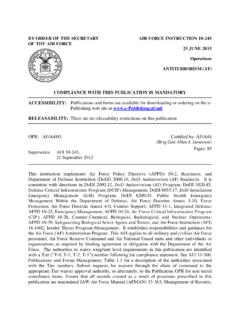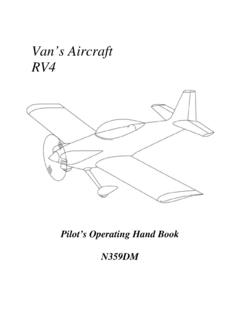Transcription of BY ORDER OF THE SECRETARY AIR FORCE INSTRUCTION 10 …
1 BY ORDER OF THE SECRETARY AIR FORCE INSTRUCTION 10-2402. OF THE AIR FORCE . 29 AUGUST 2017. Operations CRITICAL ASSET RISK. MANAGEMENT PROGRAM. COMPLIANCE WITH THIS PUBLICATION IS MANDATORY. ACCESSIBILITY: Publications and forms are available on the e-Publishing website at for downloading and ordering RELEASABILITY: There are no releasability restrictions on this publication OPR: HQ USAF/A3OA Certified by: AF/A3O. (Mr. Steven A. Ruehl). Pages: 46. This Air FORCE INSTRUCTION (AFI) implements the DoDI , Defense Critical Infrastructure Program (DCIP) Management. It provides guidance and procedures to manage the identification, prioritization, and assessment of Defense Critical Infrastructure (DCI) and assigns responsibilities governing risk management including the acceptance, remediation, and/or mitigation of DCI risks.
2 This INSTRUCTION designates AF/A3OA as the Air FORCE 's (AF) single Office of Primary Responsibility (OPR) for the Air FORCE Critical Asset Risk Management (CARM) Program and authorizes it to establish and assign roles and responsibilities necessary for the execution of the program, thereby fulfilling AF DCIP obligations laid out in DODI The AF CARM. Program's primary focus is the identification, assessment, analysis, and management of risk of loss to assets and supporting infrastructure deemed critical to execution of DoD and AF core capabilities, functions, and missions. This INSTRUCTION is applicable to Headquarters Air FORCE (HAF), Major Commands (MAJCOM), Field Operating Agencies (FOA), Direct Reporting Units (DRU), Primary Support Units (PSU), Combatant Commands (CCMD), and Air National Guard (ANG).
3 This AFI may be supplemented at any level. Route an informational copy to AF/A3OA. after certification and approval. Refer recommended changes and questions about this publication to the OPR using the AF Form 847, Recommendation for Change of Publication;. route AF Form 847 from the field through the appropriate functional chain of command. The authorities to waive the requirements identified in this publication are identified with a tier ( T-0, T-1, T-2, T-3 ) number following the compliance statement. See AFI 33-360, Publications and Forms Management, Table for a description of the authorities associated with the tier numbers. Submit requests for waivers through the chain of command to the appropriate tier 2 AFI10-2402 29 AUGUST 2017.
4 Waiver Approval Authority, or alternately, to the Publication OPR for non-tiered compliance items. AF units on Joint Bases must continue to comply with AF guidance to ensure their Task Critical Assets (TCA)/systems/capabilities are adequately managed. In accordance with (IAW). Joint Basing Implementation Guidance, supported/supporting units will implement Memorandums of Agreement to establish standards of support. Units that cannot meet AF. requirements by exhausting the Joint Basing Implementation Guidance adjudication process must coordinate with their MAJCOM to alleviate discrepancies. MAJCOMs that cannot resolve discrepancies will coordinate with the appropriate HAF office for final determination.
5 Ensure that all records created as a result of processes prescribed in this publication are maintained IAW. Air FORCE Manual (AFMAN) 33-363, Management of Records, and disposed of IAW the Air FORCE Records Disposition Schedule (RDS) in the Air FORCE Records Information Management System (AFRIMS). Chapter 1 PROGRAM OVERVIEW 4. Executive Summary .. 4. Program 4. 5. CARM and MA Integration Strategy .. 5. Chapter 2 ROLES AND RESPONSIBILITIES 7. SECRETARY of the Air FORCE (SECAF).. 7. Chief of Staff of the Air FORCE (CSAF).. 7. Assistant SECRETARY of the Air FORCE for Acquisition (SAF/AQ).. 7. Administrative Assistant to the SECRETARY of the Air FORCE (SAF/AA).
6 7. Chief, Information Dominance and Chief Information Officer (SAF/CIO A6).. 7. Assistant SECRETARY of the Air FORCE , Financial Management and Comptroller (SAF/FM).. 8. SECRETARY of the Air FORCE , Inspector General (SAF/IG).. 8. SECRETARY of the Air FORCE , Installations, Environment and Energy (SAF/IE).. 9. Air FORCE Surgeon General (AF/SG).. 9. Deputy Chief of Staff, Manpower, Personnel and Services (AF/A1).. 9. Deputy Chief of Staff, Intelligence, Surveillance, and Reconnaissance (ISR). (AF/A2).. 9. Air FORCE Deputy Chief of Staff, Operations (AF/A3).. 10. AFI10-2402 29 AUGUST 2017 3. Deputy Chief of Staff for Logistics, Civil Engineering, and FORCE Protection (AF/A4).
7 12. Deputy Chief of Staff for Strategic Plans and Requirements (AF/5/8).. 13. Director, Air FORCE Studies, Analyses, and Assessments (AF/9).. 13. Deputy Chief of Staff, Strategic Deterrence and Nuclear Integration (AF/A10).. 13. MAJCOM/DRUs.. 13. AF Installation and Mission Support Center (IMSC).. 16. Air FORCE Components to the Combatant Commands.. 17. FOAs.. 17. Air FORCE Critical Asset Owning Centers and Wings.. 19. Air FORCE Host Centers and Wings.. 21. Chapter 3 CARM PROCESSES 22. The CARM Cycle.. 22. Identification of TCAs.. 22. TCA Assessment Processes.. 23. Mission Risk Analysis.. 27. Risk Management.. 28. CARM WG.. 29. Classification Guidance.
8 29. Baseline Elements of Information (BEI).. 29. Chapter 4 CARM PROGRAM TRAINING AND OUTREACH 30. The CARM training and outreach program will .. 30. Several methods of remote delivery will .. 30. The HAF CARM Program office will .. 30. The specifics of the CARM training program can be found on .. 31. Attachment 1 GLOSSARY OF REFERENCES AND SUPPORTING INFORMATION 32. Attachment 2 QUICK REFERENCE CHART AND PROCESS OVERVIEW 40. Attachment 3 RISK RESPONSE PLAN (RRP) TEMPLATE 43. 4 AFI10-2402 29 AUGUST 2017. Chapter 1. PROGRAM OVERVIEW. Executive Summary The CARM Program was established to increase the reliability of assets/capabilities essential to the execution of DoD missions worldwide.
9 The CARM program enables continuity in two ways: 1) by identifying those systems and assets on which AF missions rely for functionality, and 2) then implementing a risk management strategy designed to reduce or offset the risk of loss to these TCA/ systems/capabilities. The CARM risk management approach includes four macro processes (identify, assess, analyze, and manage mission risk). which seek to introduce mitigation and remediation measures across its capabilities to increase mission resiliency. The Critical Asset Identification Process (CAIP), outlined in DoDM V1, Defense Critical Infrastructure Program (DCIP): DoD Mission-Based Critical Asset Identification Process (CAIP), is designed to be conducted across the DoD on a 3-year cycle or when there is a change in assigned missions or capabilities.
10 The process begins at the mission owner level and then works downward through the AF structure. Assessment and analytical products identify threats and hazards to TCAs and provide leadership with courses of action (COA) to reduce or offset risk. These products contribute to risk decisions at the HAF, CCMD, MAJCOM/DRU, FOA, and Joint Staff (JS) levels. The CARM program seeks to reduce risk by providing information to AF senior leadership (to include the Acquisitions and Sustainment communities), thus optimizing decisions on the allocation of remediation resources and future asset investment planning. Many AF Mission Assurance (MA) programs have overlapping responsibilities and focus areas.
















